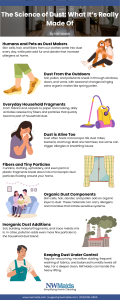A fine layer of dust on shelves or countertops may seem ordinary, but it’s far more complex than it looks. This everyday buildup of airborne particles provides surprising insights into your health, home environment, and even the world outside.
By understanding what household dust is made of, you’ll not only keep your home cleaner but also improve your overall indoor air quality.
Why Understanding Dust Matters
Health Implications of Dust
Dust isn’t just unsightly—it can directly affect your health.
Household dust particles often include pollen, pet dander, and dust mites, all of which can trigger sneezing, coughing, and skin irritation.
For people with asthma or allergies, these particles can significantly worsen symptoms.
Dust also contains bacteria, mold spores, and fine particulate matter that reduce indoor air quality. Over time, constant exposure to these contaminants may contribute to respiratory problems, fatigue, or headaches.
Environmental Insights from Dust
Dust also serves as an environmental marker. Scientists study dust composition to learn about air pollution levels, regional plant species, and even how people live inside their homes.
Because dust collects both indoor debris and outdoor particles, it provides a unique snapshot of your living environment.
The Building Blocks of Dust
Human and Pet Contributions
One of the biggest contributors to indoor dust is us—humans and pets.
People shed millions of skin cells every day, many of which become part of household dust. Clothing and upholstery also release microscopic fibers that float in the air before settling on surfaces.
Pets add fur and dander to the mix, creating a unique dust profile in every home. If you own a dog or cat, your dust will naturally contain higher levels of pet-related allergens.
Outdoor Particles
Not all dust originates indoors. Outdoor dust particles enter your home through windows, doors, and HVAC systems. Common contributors include soil, pollen, and pollutants from vehicles and industry.
Seasonal changes make a difference too—spring pollen and autumn leaves release organic matter that easily becomes part of your household dust.
Household Material Fragments
Daily activities create dust from household materials. Fabrics, carpets, and furniture release fibers, while paper, cardboard, and cooking generate fine particles.
Something as simple as opening a book or folding laundry can release fragments into the air.
Microbial Life in Dust
Dust isn’t only made of dead matter—it also harbors living organisms.
Dust mites feed on shed skin cells and thrive in warm, humid areas. Alongside mites, dust often contains bacteria and fungi.
While most are harmless, some microorganisms can trigger allergic reactions or worsen respiratory conditions, underscoring the importance of dust control in homes.
The Composition of Dust in Detail
Fibers and Particles
Microscopic analysis reveals that dust is a complex mixture of fibers and fragments. Textile fibers from curtains, upholstery, and clothing are especially common.
Paint chips, paper shreds, and even tiny bits of plastic can also be found, varying from home to home.
Organic Matter
Organic elements in dust include hair, skin cells, pet dander, and pollen. These materials often carry microbes and allergens, especially when exposed to heat or moisture.
For allergy sufferers, this type of organic dust is often the main culprit.
Inorganic Material
In addition to organic matter, dust contains inorganic components like soil particles, fragments of building materials, and trace metals.
In urban settings, pollution adds high levels of fine particulate matter, further complicating the dust composition in homes.
Dust and Indoor Air Quality
How Dust Travels
Dust never stays still. Air circulation from fans, heating systems, and daily movement keeps dust particles suspended in the air, spreading them throughout your living space.
This explains why electronics, ceiling fans, and hard-to-reach corners often accumulate significant buildup.
Managing Dust Effectively
Understanding what dust is made of is the first step toward managing it. A few effective strategies include:
-
Vacuuming regularly with a HEPA filter vacuum
-
Dusting with microfiber or damp cloths
-
Washing bedding, curtains, and upholstered furniture often
-
Keeping humidity levels balanced to discourage dust mites
For homeowners who prefer a professional touch, NW Maids cleaning services specialize in tackling dust at the source, leaving your home cleaner, healthier, and more comfortable.
Fun Facts About Dust
Ancient Dust
Dust has been around for centuries. Archaeologists use layers of ancient household dust to uncover details about food, daily life, and environmental conditions.
This makes dust a time capsule of history.
Dust Diversity
No two homes have the same dust. Its composition depends on climate, location, and lifestyle habits. Rural homes may contain more soil and pollen, while urban homes collect pollution-based dust particles.
This diversity makes dust surprisingly unique to every household.
Conclusion: The Science of Dust and Your Home
The science of dust reveals just how much information these tiny particles carry.
From organic matter like skin cells and pet dander to inorganic pollutants and microbial life, dust is a complex and ever-changing mix.
By learning more about what dust is really made of, you can adopt better cleaning strategies to protect your health and improve indoor air quality.
And if you’d rather leave the job to the experts, NW Maids offers professional cleaning services designed to eliminate dust buildup and keep your home fresh, healthy, and dust-free.
Related Posts:
- Top Traits of an Exceptional House Cleaner
- The Best Green Cleaning Products for Every Room
- How to Clean Houseplant Leaves
- Holiday Cleanup Guide: How to Tidy Up After Guests
← How to Keep a Tidy Home When You’re a Pet Owner
Essential Cleaning Tips for Airbnb Hosts to Get 5-Star Reviews →






